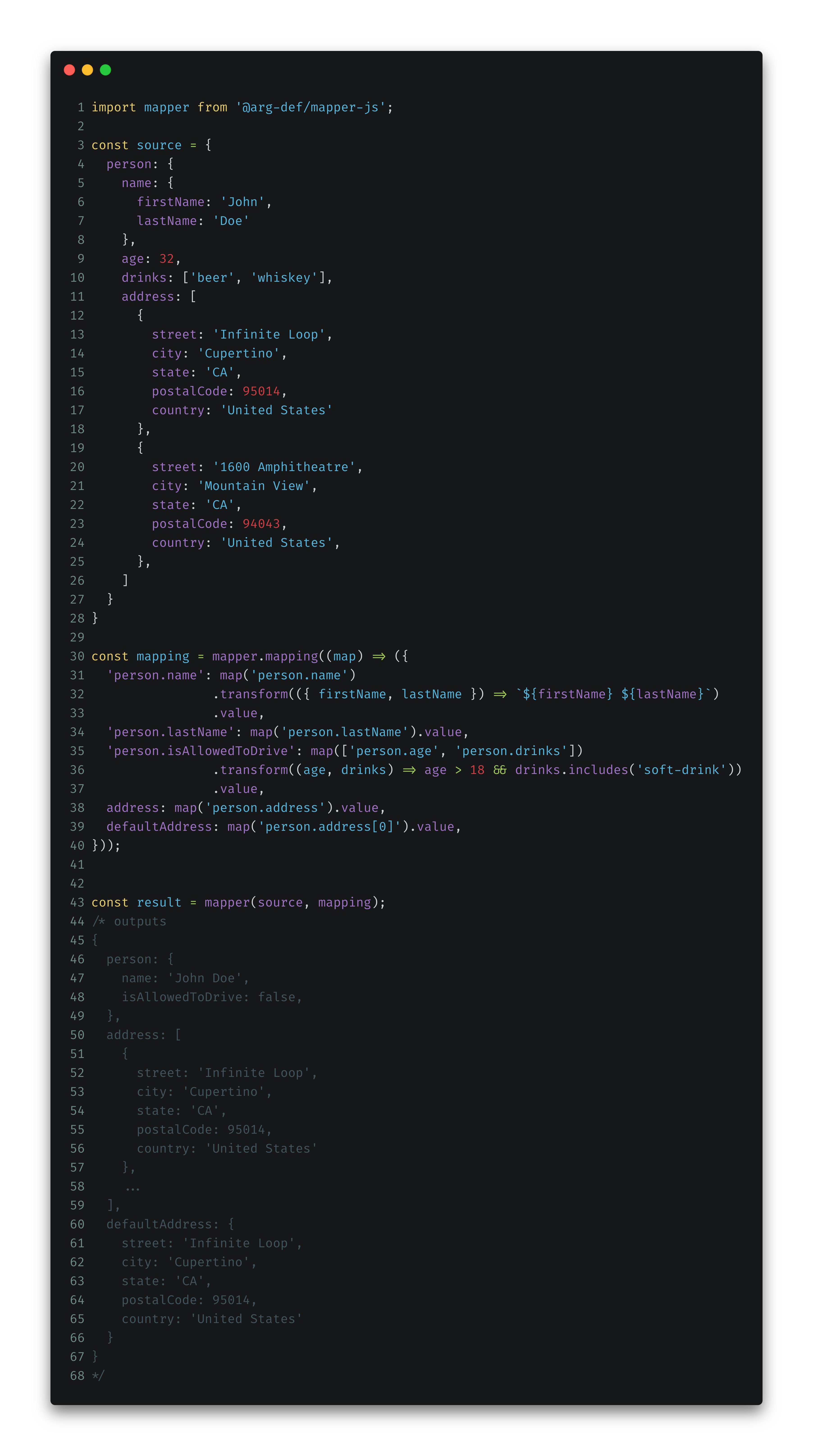@arg-def/mapper-js
Fast, reliable and intuitive object mapping.
Demo
Play around with mapper-js and experience the magic!
Installation
npm install @arg-def/mapper-js --save
#or
yarn add @arg-def/mapper-jsHow to use
1) Know the structure from your source data
Before we start, it is essential that we know your data structure so we can map it accordingly.
For this demo case, let's assume that we have the following object:
const source = {
person: {
name: {
firstName: 'John',
lastName: 'Doe'
},
age: 32,
drinks: ['beer', 'whiskey'],
address: [
{
street: 'Infinite Loop',
city: 'Cupertino',
state: 'CA',
postalCode: 95014,
country: 'United States'
},
{
street: '1600 Amphitheatre',
city: 'Mountain View',
state: 'CA',
postalCode: 94043,
country: 'United States',
},
]
}
}2) Create your mapping using dot notation
At this step, we need to create our mapping against our data source.
We will be using dot notation to create our final structure.
For more info about
dot notationAPI, check out the documentation
With mapper, it is possible to get one or several values from our source
and even transform it in the way we need.
For that, map() accepts single dot notation path or
an array of dot notation paths. E.g.: map('person.name.firstName'), map([person.name.firstName, person.name.lastName]);'
Those values can be transformed by using the .transform() method, which expects a function as argument and provides
the selected values as array in the parameter.
For more information about the usage, check the API Documentation.
Now let's create our mapping!
import mapper from '@arg-def/mapper-js';
...
const mapping = mapper.mapping((map) => ({
'person.name': map('person.name')
.transform(({ firstName, lastName }) => `${firstName} ${lastName}`)
.value,
'person.lastName': map('person.lastName').value,
'person.isAllowedToDrive': map(['person.age', 'person.drinks'])
.transform((age, drinks) => age > 18 && drinks.includes('soft-drink'))
.value,
address: map('person.address').value,
defaultAddress: map('person.address[0]').value,
}));3) Create your mapped object
import mapper from '@arg-def/mapper-js';
...
const result = mapper(source, mapping);
/* outputs
{
person: {
name: 'John Doe',
isAllowedToDrive: false,
},
address: [
{
street: 'Infinite Loop',
city: 'Cupertino',
state: 'CA',
postalCode: 95014,
country: 'United States'
},
...
],
defaultAddress: {
street: 'Infinite Loop',
city: 'Cupertino',
state: 'CA',
postalCode: 95014,
country: 'United States'
}
}
*/API Documentation
mapper
Type: function()
Parameter: source: object, mapping: IMapping, options?: IMapperOptions
Description:
mapper() mappes your source data against your mapping.
It accepts an extra (optional) argument defining the global mapping options.
Example:
mapper(source, mapping, options);
/* outputs
{
employee: {
name: 'John',
age: 32,
address: [
{
street: 'Infinite Loop',
city: 'Cupertino',
state: 'CA',
postalCode: 95014,
country: 'United States'
},
...
],
},
}
*/mapper.mapping
Type: function()
Parameter: map
Signature: (callback: IMapping): IMapping => callback;
Description:
mapper.mapping() is the method responsible for mapping the values from your source data against your object shape.
It accepts dot notation path as key.
Example:
// raw definition
const mapping = mapper.mapping((map) => ({
...
}));
// with map() query
const mapping = mapper.mapping((map) => ({
'employee.name': map('person.name.firstName').value,
'employee.age': map('person.name.age').value,
'employee.address': map('person.address').value,
}));
map
Type: function
Parameter: paths: string|string[], option?: IMapperOptions
Signature: <T>(key: string | string[], options?: IMapperOptions) => IMapMethods<T>;
Description:
root method retrieves values from your source data using dot notation path, it accepts a string or array of string.
It accepts an extra (optional) argument to define the mapping options for current entry, overriding the global mapping options.
Example:
map('person.name.firstName');
map(['person.name.firstName', 'person.name.lastName']);
map(['person.name.firstName', 'person.name.lastName'], options);
transform
Type: function
Parameter: ...unknown[]
Signature: (callback: (...args: unknown[]) => T) => IMapMethods<T>
Description:
.transform method provides you the ability to transform the retrieved value(s) from map() according to your needs, and for that, it expects a return value.
.transform provides you as parameter, the retrieved value(s) in the same order as defined in the map() method, otherwise
Example:
// single value
map('person.name.firstName')
.transform((firstName) => firstName.toLoweCase());
// multiple values
map(['person.name.firstName', 'person.name.lastName'])
.transform((firstName, lastName) => `${firstName} ${lastName]`);
value
Type: readonly
Returns: T
Description:
.value returns the value of your dot notation query. If transformed, returns the transformed value.
Example:
// single value
map('person.name.firstName')
.transform((firstName) => firstName.toLoweCase())
.value;
// multiple values
map(['person.name.firstName', 'person.name.lastName'])
.transform((firstName, lastName) => `${firstName} ${lastName]`)
.value;Mapper Options
defaults
{
suppressNullUndefined: false,
suppressionStrategy: () => false,
}Details
suppressNullUndefined
Type: boolean
default value: false
Description:
Removes null or undefined entries from the mapped object.
Example:
/* source object
{
person: {
name: 'John',
lastName: 'Doe',
age: 32,
},
}
*/
const mapping = mapper.mapping((map) => ({
'name': map('person.name').value,
'age': map('person.age').value,
// source doesn't have property 'address',
// therefore will return "undefined"
'address': map('person.address').value,
}));
mapper(source, mapping, { suppressNullUndefined: true });
/* outputs
{
name: 'John',
age: 32,
}
*/suppressionStrategy
Type: function
Parameter: value: unknown
Signature: (value: unknown) => boolean
Description:
Defines a custom strategy to suppress entries from the mapped object.
Example:
/* source object
{
person: {
name: 'John',
lastName: 'Doe',
age: 32,
address: {
street: 'Infinite Loop',
city: 'Cupertino',
state: 'CA',
postalCode: 95014,
country: 'United States',
}
},
}
*/
const customSuppressionStrategy = (address: ISource): boolean => address && address.city === 'Cupertino';
const mapping = mapper.mapping((map) => ({
'name': map('person.name').value,
'age': map('person.age').value,
'address': map('person.address').value,
}));
mapper(source, mapping, { suppressionStrategy: customSuppressionStrategy );
/* outputs
{
name: 'John',
age: 32,
}
*/







